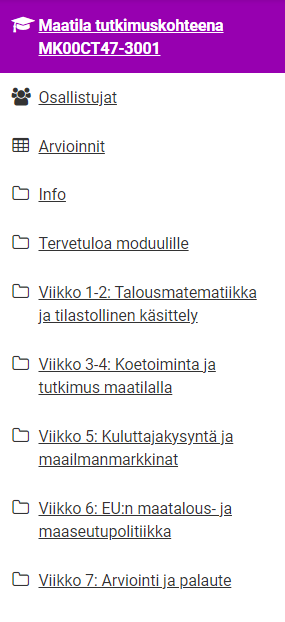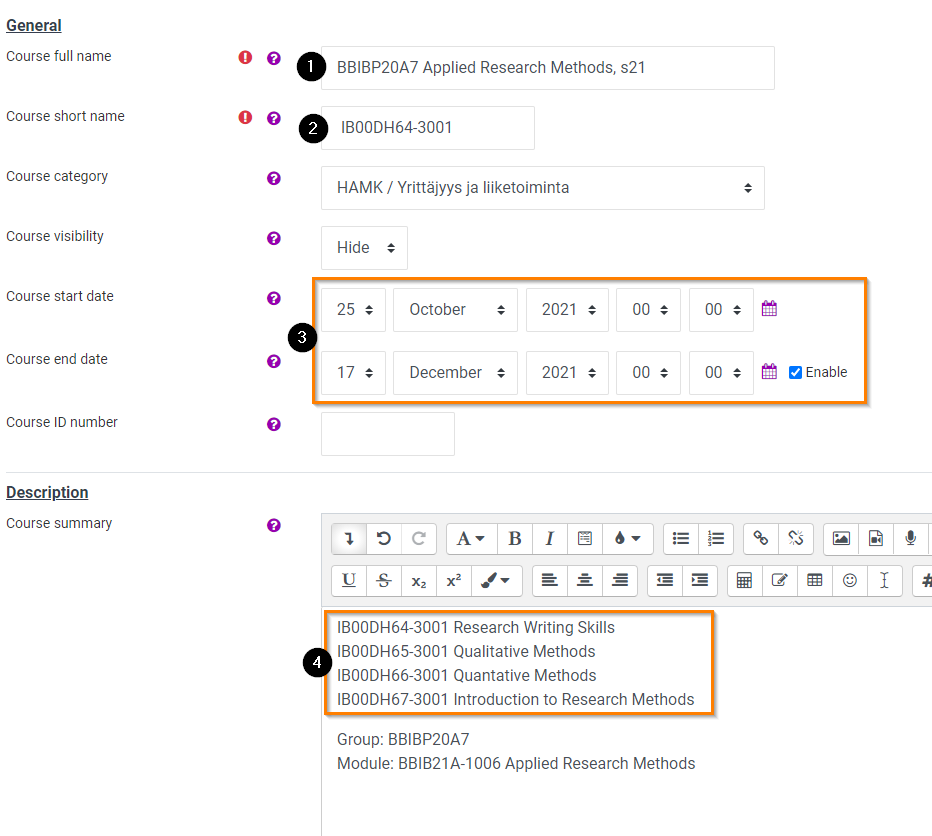Notice: Undefined variable: post_id in /data/wordpress/htdocs/wp-content/plugins/pressapps-knowledge-base/public/partials/page/page-single.php on line 41
Moodle courses for modules can be built in different ways

Article sections
Introduction: Curriculum reform
HAMK has done extensive work curriculum reform (OPS), about which vice-rector Heidi Ahokallio-Leppälä wrote a news intra on 27 October 2020 (requires login). Extracts from the news:
- The module is a tight, unified whole, the basis of which are the phenomena of working life
- Working life projects are done in the modules, both students and teachers work in teams
- Uniform timing of the academic year, where the modules are implemented consecutively
- The module set is on the same Learn (Moodle) platform, on which the module’s teachers plan and build the implementation of the module together. On the learning platform, e.g. creating the module, assignments and evaluation during implementation.
These strengths will also be maintained in the future and will be further strengthened. The modular structure has proven its functionality, which can be seen e.g. over the years as continuously improved student feedback. However, the operating environment is constantly changing, which means that we also still need both pedagogical and structural curriculum development.
Instruction description
This guide presents different solutions for the implementation of different curricula from the perspective of Pepi and Moodle. You can also use the combination of the solutions presented here that best serves the needs of your own module. The workspace that assembles the module must exist in any case. More about creating implementations (Yammer 1.4.2021)
General instructions related to Moodle workspaces
Implementations according to the new curriculum
Module X: one course, one workspace
The module has one course with its own workspace in Moodle. Pictorial instructions: Setting up a workspace through Peppi.
Work steps:
- the module implementation is set up in Pepi and the teacher resources for the implementation are defined
- the module manager adds a workspace to the module implementation
- Teachers connected to the module in Peppi are automatically connected as teachers to the workspace
- student registration and joining Moodle workspaces
- students register for the module implementation in Pakki
- registered students are accepted for the module implementation in Peppi, in which case they are also automatically connected to the module’s Moodle workspace

An example of the breakdown of the content of the module implementation in Moodle (picture)
Module Y: four study courses, one workspace
The module has four study courses that have a common workspace in Moodle. The common workspace is the workspace of one study course, with which the other study courses of the module are combined. Pictorial instructions: Combining workspace for several different study courses.
- Creating a workspace
- The teacher of the study course belonging to the module adds a workspace in Peppi to his own implementation in Moodle on the Learning Environments tab. This workspace is used as the common workspace of the module. Pictorial instructions: Setting up a workspace through Peppi.
- The name of the workspace is edited in Moodle to match the name (study unit) in the module’s OPS, and the implementation codes and names of the study courses included in the module are entered in the description of the workspace.
- Connecting other study courses in Peppi to a common Moodle workspace. Pictorial instructions: Combining workspace for several different study courses.
- In Moodle, the abbreviation of the created workspace is copied and with it, in Pepi, the other study courses belonging to the module are connected to the same Moodle workspace. The workspace short is attached to each implementation to be connected.
(Learning environments – Add a workspace to the learning environment: Attach to an existing Moodle workspace). The people involved in the implementation move to the Moodle workspace with the link.
- In Moodle, the abbreviation of the created workspace is copied and with it, in Pepi, the other study courses belonging to the module are connected to the same Moodle workspace. The workspace short is attached to each implementation to be connected.
- Student registration and joining the Moodle workspace
- Students register for study courses in Pakki.
- Enrolled students are accepted for study courses in Peppi, whereupon they are also automatically connected to the course’s Moodle workspace.
- Checking participants in Moodle:
- Participants -> Check that the teachers are on the participant list. Also check that they see the correct implementation IDs as group information.

An example of the basic data of the combined implementation workspace (picture):
- In Moodle, the name of the workspace has been corrected to match the OPS name of the module/study unit, the group ID and the date of implementation have been added to the beginning (s21/k22)
- The abbreviation corresponds to the original implementation
- The date of the study is defined in the basic information of the workspace.
- The implementation codes and names of the study courses and the group for which the implementation is aimed have been added to the description. It is good to see the name of the module, the module code is not mandatory.
Module Z: four study courses, separate workspaces (only in special cases)
A workspace (home base) that integrates into Moodle has been created for the module. Each Study Course has its own workspace. The workspaces of the study courses are connected as sub-workspaces of the assembling workspace (home nest). The total grades of all sub-workspaces are automatically shown in the evaluation book of the collecting workspace (home nest).
- the module’s assembling workspace (home nest) – separately ordered workspace (In Moodle, in the top menu, Info -> Order workspace)
- professional content 1 (5 ECTS) – sub-work space 1
- professional content 2 (5 ECTS) – subwork space 2
- communication (2 ECTS) – underwork space 3 // shared with other implementations in the education sector
- mathematics (3 ECTS) – underwork space 4 // shared with other implementations in the education sector
Steps:
- Course implementations are established in Peppi.
- Teachers are defined for the course.
- Let’s add a workspace for each implementation of the course.
- The teachers attached to the study course are automatically connected as teachers to the to the workspace.
- The Module Manager orders the assembling workspace (home base) in Moodle.
- The module manager adds teachers to the home nest manually.
- Course-specific Moodle workspaces are added as sub-workspaces to Kotipesa, so that the entire module can be seen in Moodle.
- All sub-workspaces are connected to the assembling workspace (home base) with metal link so that the students can see the module as a whole. Only students can join with Metalink.
- The total grades of all sub-workspaces are automatically shown in the evaluation book of the collecting workspace (home nest).
- Student registration and joining Moodle workspaces
- Students register for study courses in Pakki.
- Enrolled students are accepted in Pepi for the study course, whereupon they are also automatically connected to the study course’s own workspace and, with a metal link, also to the module’s home nest.
- In subworkspace
- All sections affecting the evaluation are evaluated in Moodle.
- The evaluation is done according to the module’s common evaluation criteria, e.g. the scores of the assignments and exams and the determination of the course grade.
Module implementations according to the old curriculum (started before 2021)
From the above instructions Module X and Module Z as applicable.
How do I name the workspace in Moodle? What is the abbreviation for workspace?
The name and description of the workspace are important because Moodle can search for the workspace based on these texts. The basic information of each workspace must show the implementation ID/IDs and the group ID/IDs to which the implementation is directed.
Workspace name
- Peppi names Moodle workspaces automatically: name implementation ID
- Can be modified if necessary, for example like this – or as agreed upon by the training:
SHHTP20A2 Nursing…, s21/k21
group ID study course/module, date - To complement the standard name, no more than group ID and date (s21/k21)
Description of the workspace
- If multiple implementations are combined, enter the implementation IDs of all implementations here.
- If the implementation is aimed at several groups, enter all group IDs here.
Abbreviation for workspace
- The main purpose of the workspace abbreviation is to connect workspaces in Peppi.
- The workspace abbreviation appears in the headers of e-mail notifications sent to the user and in the links included in the message, as well as in some workspace listings.
- Workspaces created through Pepi: the abbreviation is automatically the implementation ID (can be kept)
- The workspace abbreviation must be unique.
Notice: Undefined variable: output in /data/wordpress/htdocs/wp-content/plugins/pressapps-knowledge-base/public/partials/page/page-single.php on line 83
